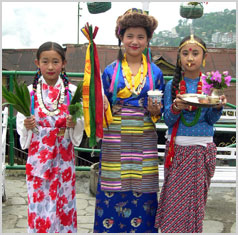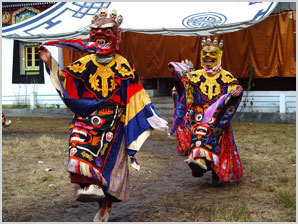Sikkim and Sikkimese
Culture

|
Sikkim Topography |
||
| Total Area | 7,096 sq kms | |
| Latitude | 27-28° North | |
| Longitude | 88-89° East | |
| Population | 4,91,000 | |
| Population of Buddhist | 28% | |
| Hindus | 67% | |
| State Animal | Red Panda | |
| State Bird | Blood Pheasant | |
| State Flower | Nobile Orchid | |
| State Tree | Rhododendron | |
| Cash Crops | Cardamom, Tea and Ginger | |
Sikkim, a small north easternly state of India,
located long sequestered in the laps of the Himalayas.
The paradise of Eastern Himalayas, smallest of the
Indian states, Sikkim has an area of 7,096 sq. kms and
population of around three lakhs. This gentle, green
state in the northeast is surrounded by Nepal, Bhutan
and China hence strategically it becomes very important.
It was a common thought that Sikkim is tucked away in
some remote and vague corner of India. But this is not
true. Come and feel the culture, the scenic beauty of
the state. Trek the mountain peaks. Enjoy the sunrise of
Kanchandjangha. Understand the reach Buddhist religion.
Tourists and scholars alike create a great demand for
information of this area.
The pristine and unspoiled natural beauty includes
Alpine landscape, thick luxuriant tropical forests
torrents rivers, high mountain peaks of the great
Himalayan range and peaceful lakes - a true Sangrila.
The story of Sikkim echoes the land itself - an ardous
landscape of peaks and valleys that rise and fall like
its tumultuous history. Tours and Treks, passion for
learning Buddhism form the integral part of touring
Sikkim.
Among all the hill stations and tourist places in the
Himalayas, Sikkim has some of the best roads.
Here below, there are four regions (East, West, North
and South) for the information of the viewers and
interested tourists. For more information on Sikkim and
tours & treks, please feel free to write to us.
Sikkimese Culture
Communities, Culture, Religions and Customs of
different hues intermingle freely here in Sikkim to
constitute a homogeneous blend.
The "ruling" family is of Tibetan origin. Sikkim was a
dependency of Tibet until the British Government in
India established its protectorate in 1890. In 1974
Sikkim was merged with India, and became India's 22d
state.
Sikkim is statistically the safest state in India.
Lowest property crime rate, bodily harm rate. Due to
China
Border proximity, there is a huge army presence which
gives mixed benefits of many non-native persons not
respecting local traditions, but also economic advantage
to small shops and public projects especially roads.
 The
people of Sikkim are simple and friendly with natural
gaiety. The customs and rituals of Sikkim are as diverse
as the ethnic that inhabit the land. The predominant
communities are the LEPCHAS, BHUTIAS, NEPALESE and
smaller proportions of LIMBUS.
The
people of Sikkim are simple and friendly with natural
gaiety. The customs and rituals of Sikkim are as diverse
as the ethnic that inhabit the land. The predominant
communities are the LEPCHAS, BHUTIAS, NEPALESE and
smaller proportions of LIMBUS.
All communities live in perfect harmony sharing each
other's culture, ethos, and traditions with the result
there is now a Sikkimese culture, which is composite of
all the three prominent communities. Most of the people
speak Nepali, which is also the state language. It is
the harmony of the place that provides justification to
the name of the state derived form "Sukhim", meaning
"happy home, a place of peace".
The Sikkimese culture finds expression in it's beautiful
art and craft. Knotted woollen carpets with the
dominating dragon emblem, and eight auspicious signs;
wood carvings, Lepcha handlooms in traditional designs
and rich colours for clothes, bags, linen and
accessories; leather jackets and handbags, articles of
homemade paper, Thanka (religious scroll paintings) and
Sikkimese Dragon Jewellery make a fascinating collection
of handicrafts, inspired by an age old culture.
Those who have lived in Sikkim long enough will testify
that life here is, in a sense, an ongoing festival. Life
in Sikkim, like in the rest of India, is rooted firmly in
religion. Everything a person does is related to his
faith. His daily life is governed by the patterns and
customs of his religion. The majestic Mount
Khangchendzonga- earth's third highest mountain range,
plays a dominant role in the Sikkimese life. For those
visiting Sikkim, the festivals of this place, offer a
unique opportunity to participate and sample the rich
traditions of an ancient culture; as well as the warmth
and hospitality of a friendly people.
Sikkim, like in the rest of India, is rooted firmly in
religion. Everything a person does is related to his
faith. His daily life is governed by the patterns and
customs of his religion. The majestic Mount
Khangchendzonga- earth's third highest mountain range,
plays a dominant role in the Sikkimese life. For those
visiting Sikkim, the festivals of this place, offer a
unique opportunity to participate and sample the rich
traditions of an ancient culture; as well as the warmth
and hospitality of a friendly people.
The people of Sikkim love to celebrate. Be it the
chasing away of the evil spirit or the celebrations on
the occasion of the New Year, the Sikkimese do it all
with a gay abandon. And if you're fortunate you could
persuade the Sikkimese to offer you 'Chaang' a
preparation from fermented millet. The drink is served
to you in hollow bamboo pipe.
There is an incessant row of festivities in Sikkim.
Buddhism and Hinduism, are the main religions, as is
exhibited in many of the celebrations. The traditions of
the Lapchas display rich cultural heritage. Enchey,
Phoodong, Lachung, Pemayangtse, Tsuklakhang, and Rumtek
are some of the beautiful monasteries where festivals
are held. Pang Lhabsol, Drukpa Tseshi, Losoong, Saga
Dawa and Dusain are the main festivals. Buddhism has
been practiced in true sense on Sikkim. People visit the
monastery to interact with the Buddhist monks to know
more about Buddhist cult.
Photo Gallery
Client Testimonials
![]()
 Dear Zigmee
Thanks for a fabulous time in North Sikkim, highlight of the trip were staying with Chopal and sonam lachenpa in lachen and the journey to Gurudargma (well worth the many hours in the jeep and the cold air). It wasn't hard to imagine just being over the border in
Dear Zigmee
Thanks for a fabulous time in North Sikkim, highlight of the trip were staying with Chopal and sonam lachenpa in lachen and the journey to Gurudargma (well worth the many hours in the jeep and the cold air). It wasn't hard to imagine just being over the border in
Copyright © 2011 All Rights Reserved
Powered By : Rumtek Technologies





















